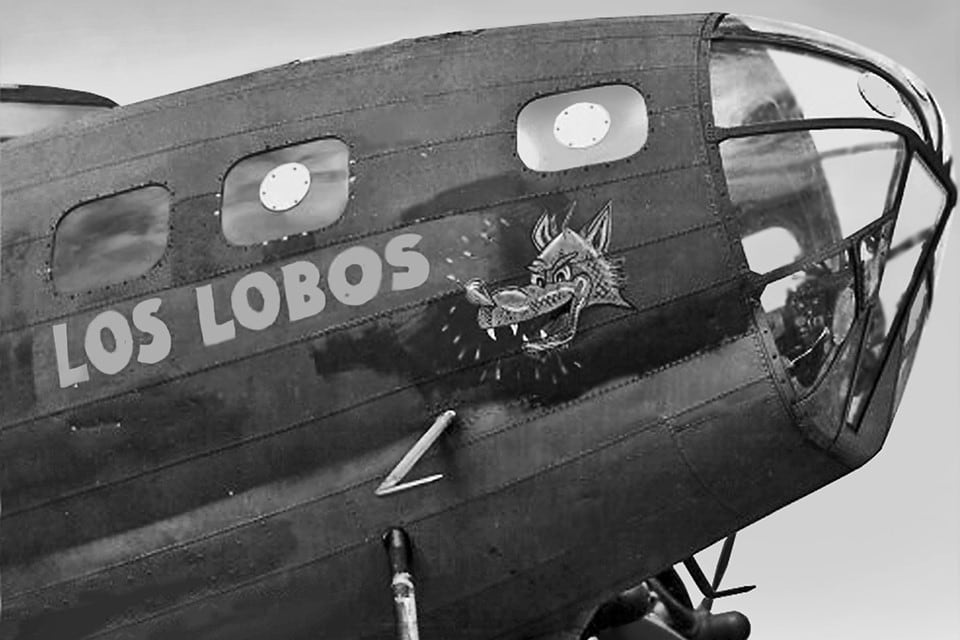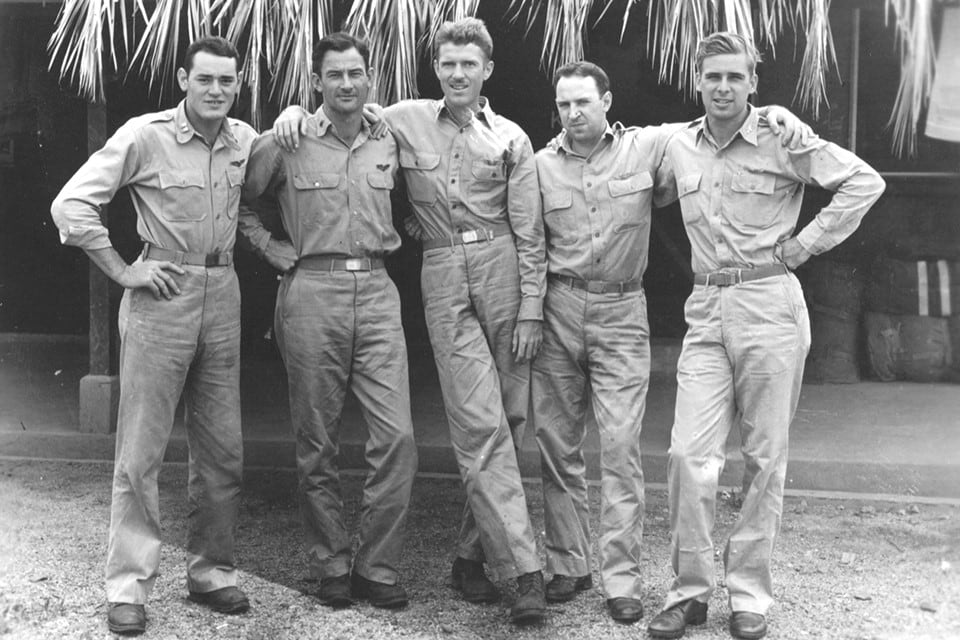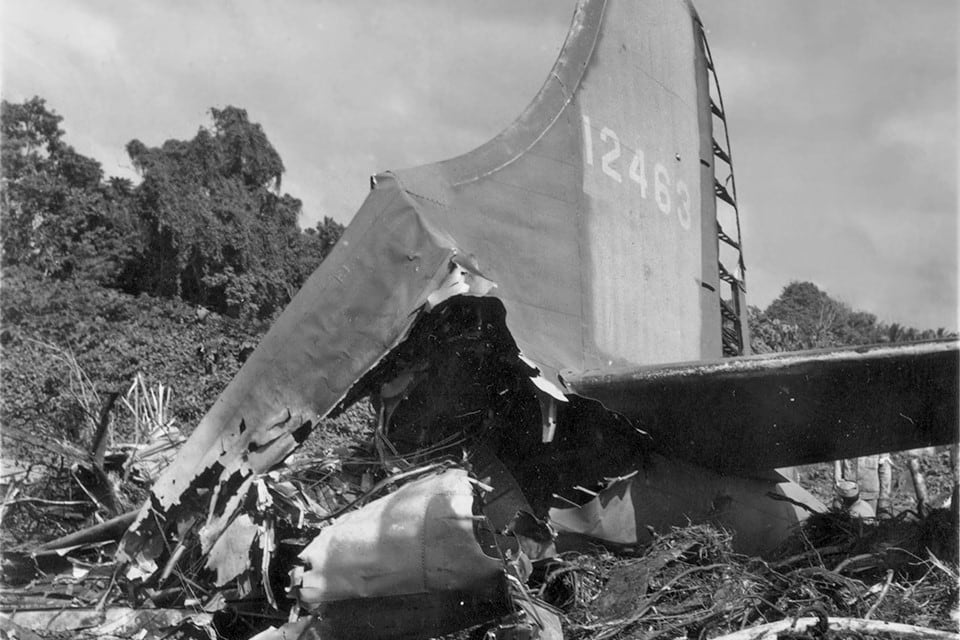2nd Lt. Eugene Wesley Roddenberry was just 21 years old when he reported for duty in September 1942 as a copilot with the 394th Bombardment Squadron at Bellows Field on Oahu. Since the Japanese attack on Pearl Harbor, the 394th had been patrolling the ocean around Hawaii and training crews. Now it was preparing to go into action in the South Pacific under its new commander, West Pointer and Midway veteran Maj. Orin H. Rigley.
Gene Roddenberry was assigned to the crew of Lt. William Ripley. Beefy, ruddy Bill Ripley was a preacher’s son from Des Moines, Iowa. Other members of the crew included navigator Lt. Joe Jacobs, bombardier Tech. Sgt. James Kyle and flight engineer Staff Sgt. Harry Scotidas.
The 394th was ready; now all the aircrews needed was their new airplanes.
The question was, where would those new planes come from? The decision had already been made that no new B-17s would be sent to the Pacific, so it seemed likely the 394th would become a B-24 outfit.
The answer arrived in early November 1942 in the form of a dozen war-weary 19th Bomb Group B-17Es, homeward bound from Australia. After inspection, seven of the old bombers were held over for reassignment to the 394th.
By the time they were delivered to Bellows Field, the Flying Fortresses had been thoroughly overhauled and fitted with twin .50-caliber nose guns and other modifications. A few still displayed the Indian head insignia of the 93rd Bomb Squadron, and a couple had nicknames: serial no. 41-2440, the oldest of them all, was Calamity Jane; 41-2632 was Crock O’ Crap.
The 394th pondered a new question: “Would we ever get down there in those old things?”
The seven southbound B-17s took off from Bellows on November 15, led by Major Rigley in Crock O’ Crap, flanked by Captain Morris Slack in Calamity Jane and Lieutenants Ripley and Roddenberry in 41-2644.
In a sign of things to come, Rigley was forced to return to Hawaii with mechanical problems and Captain William Ivey in 41-2642 turned back with a dead engine and a dangerously windmilling propeller. The other five landed safely at Kiritimati Island, then continued on to Canton and Fiji, landing at Nadi (also spelled Nandi) on Viti Levu in the afternoon of November 18. Rigley arrived the following day, and Ivey caught up two days after that.
The squadron was tasked with patrolling the seas around Fiji to protect the vital southern route to Australia. Like all the squadrons of the 5th Bomb Group, they would also be required to fly strike missions from Guadalcanal.
The men of the 394th began a daily routine of conducting two and sometimes three frontal sea searches—700 miles out, 100 miles across, 700 miles back—and were settling comfortably into their new home when a body blow came in the form of two Douglas SBD Dauntlesses from Scouting Squadron 6. A night familiarization exercise went badly astray when the U.S. Navy pilots apparently became confused about exactly where the runway lights were and crashed into two B-17s parked beside the airstrip.
The 394th’s intelligence officer, Captain Myron Scott, reported that the first SBD “sliced off the nose” of Calamity Jane “as though it were baloney” and the other slammed into the middle of Captain McLyle Zumwalt’s 41-2658, “bending it like a hairpin.” Nobody was seriously injured but it was a heartbreaking start to the deployment. Calamity Jane would fly again, but Zumwalt’s bomber was a write-off—although also a handy source of parts.

The order they had been waiting for came through around 9 p.m. on January 2, 1943, when all available planes and crews were ordered to fly to Henderson Field on Guadalcanal by way of Espiritu Santo in the New Hebrides.
The five B-17s carrying seven crews took off at 8 the next morning and landed at Espiritu Santo in the middle of the afternoon. Along the way Ripley, Ivey and Captain John Turner in 41-2668 all experienced mechanical problems, leaving only Rigley’s Crock O’ Crap and Captain Elmer Schoggen’s 41-2630 to complete the flight to Guadalcanal the next day. Slack and Zumwalt managed to join them by borrowing two old planes from the 11th Bomb Group, but the exasperated Ripley, Ivey and Turner crews—including Roddenberry — were left behind.
Finally, after 10 days of frustration, Ripley’s bomber was repaired and they took off on the roughly four-hour flight to Henderson Field. Perhaps unsurprisingly, an engine conked out along the way but the B-17 completed the journey in one piece.
The next day they joined a nine-plane strike force to search for a damaged Japanese destroyer reported off the coast of New Georgia. When the Americans found the destroyer, it appeared to be far from crippled and the B-17s failed to claim even near misses.
On January 16 Rigley led four 394th planes on a night strike against Kahili, the Japanese fighter strip on the southeastern tip of Bougainville. They bombed individually through sporadic anti-aircraft fire and, for what the crews believed was the first time on a night mission, they were attacked by A6M Zeros. The Japanese fighters attacked in formation and began firing from far enough away to give the B-17s time to turn toward them. Jim Kyle in the nose of 644 opened fire with his twin .50s and saw his target “fall in three burning pieces.”
On January 19 the 394th flew back to Espiritu Santo to spend the night. Spirits were high in Ripley’s B-17. Roddenberry took center stage with a stirring rendition of “The Cremation of Sam McGee,” but everyone joined in the fun and Ripley was content to let them unwind. The 394th was in the war again, and this time they were the ones dropping the bombs.

The days passed and the 394th fell back into the Fiji routine. New crews arrived, with more old planes, and lightened the workload. The men built and enthusiastically christened an officers’ club, and there was the prospect of 10 days’ leave in New Zealand for the combat crews. Roddenberry spent a lot of his spare time reading and occasionally writing verse, successfully revamping a World War I trench song as the squadron theme song. He fit in well enough, although some of his more esoteric literary references seemed condescending to the more down-to-earth officers in the 394th.
One sea search was usually much like another, but the unpredictability of the South Pacific weather was always a factor. Pre-mission forecasts, based on observations from the previous day, could be unreliable. Thus there had been no hint of what was to come when two B-17s piloted by Captains John Britton and Bill Ripley took off at about 0500 hours on a routine daily search.
Just after noon a garbled coded message from Britton’s plane indicated he had encountered extreme weather and was diverting to Espiritu Santo. There was no word from the other B-17, but nobody was unduly concerned.
Ripley was expected back around 1630, and when another hour had passed those waiting on the ground grew more anxious, straining to hear the sound of approaching engines and watching the sky. There was widespread relief when Ripley’s B-17 finally landed at 1745. A jeep was dispatched to bring the officers back to operations, but the nonplussed driver returned to explain that Ripley, Roddenberry and Jacobs had refused the ride and were walking back because, they said, they wanted “to feel the earth beneath their feet.”
At the operations office they told a harrowing story. About 600 miles into the outward leg of their search they had encountered what Ripley called a “dull gray wall” rising from the ocean and stretching as far as they could see.
“I had never seen a tropical front like that one,” said Ripley. He supposed he should have turned back, but because the front was dull gray, not black, and the weather forecast had predicted moderate conditions, he pushed on, trying unsuccessfully to find a hole in the forbidding gloom.
“So we plunged into it,” he continued. “For the first half-hour there was the turbulence to be expected, with the plane yawing and rising and falling in bumps. The rain was coming down in solid sheets and the engines began to sputter. Then a strong updraft caught us and took us from 500 feet up to 7,000 feet altitude, although both Rod and I were pushing the sticks full forward. Then just as suddenly we went downward while we both reversed the sticks, holding them back against our stomachs as far as they would go.”
In the nose navigator Joe Jacobs was on the roof of his cabin, “sitting on nothing and trying to reach the floor with my feet.” Bombardier James Kyle had been out of the nose and was now unable to get back there, so he wedged himself between the pilots’ seats. Engineer Harry Scotidas was “dodging the ammunition boxes and ammunition belts, and D-rations and junk” that “came flying through the air from one end of the plane to the other.”
The altimeter had dropped to zero when Kyle had the terrifying experience of looking past Roddenberry to see a wall of water, and spray whipping the cockpit windows. Then as if by a miracle the B-17 straightened out and they were through the front.
“There was a cushion of air right on top of the water that saved us,” Ripley concluded. “I’ll go over a strong Jap air base any day but never through a tropical front like that again.” Roddenberry was just “surprised to get out of the storm alive.”
The three left to make their way uphill to the officers’ club. On foot.
As time passed the crews grew fonder of their old warplanes, if not their Wright engines, and between searches found time to paint names on them. Schoggen’s 630 was Oklahoma Sooner, Ivey’s 642 naturally became Poison Ivey and Turner’s 668 was Chosef, with a painting of the boxing kangaroo from the Snuffy Smith comic strip on the nose. Ripley’s 644 was named Los Lobos.

In mid-April of 1943 Major Rigley was promoted and transferred to 5th Group headquarters, and McLyle Zumwalt took over the 394th Bomb Squadron.
On April 25 the air echelon was ordered to proceed to Guadalcanal for another few weeks of strike missions. Guadalcanal had been declared secure since February, although Japanese aircraft continued to carry out small but sometimes deadly night raids.
A series of bombing missions that began on April 28 was continually hampered by weather. The B-17s attempted a Bougainville strike on May 3, but were beaten back by a massive weather front. Ripley and Roddenberry tried to climb over it, but had to give up when the altimeter neared 20,000 feet.
The weather was still bad on May 11 when five B-17s managed to break through to hit various Bougainville targets. Zumwalt reported that most of the planes were over the target for more than an hour, bombing through the broken cloud. He noted that Ripley was “over the Bougainville area for over an hour and forty five minutes before he found suitable targets for all his bombs” and returned with “the tanks almost dry.” He concluded that “it was generally agreed that the Japanese received absolutely no sleep on that night.”
Zumwalt led a nine-plane strike force to Kahili and Ballale on the night of May 13. This time each B-17 was carrying six 800,000-candlepower M-26 flares in addition to the bombload. The carefully timed plan was for each B-17 to bomb by the light of the flares dropped by the previous plane, in turn releasing its own flares to light the way for the following B-17. The searchlights and anti-aircraft fire were intense, and Japanese fighters were seen but did not engage.
The run of bad weather continued as missions were repeatedly planned and then canceled.
The Navy was determined to blockade southern Bougainville by mining Shortland Harbor, but it was a dangerous mission against a well-defended target, so they called on the Army Air Forces to provide a diversion. On May 20 four 394th B-17s answered the call. Ripley and two others were carrying a load of fragmentation bombs; the fourth Fortress was loaded with 14 300-pounders. The B-17s concentrated on the searchlight and anti-aircraft positions while Navy TBF Avengers slipped in at 1,500 feet and completed their task without loss. The mission was successfully repeated three nights later with eight B-17s distracting the enemy defenses.
The 394th was relieved on June 5 and returned to Fiji, where Roddenberry learned that he was one of five copilots who had qualified as a B-17 first pilot. A week later the squadron was informed that it was leaving Fiji for good, and the last search patrols from Nadi were flown on June 16.

A third series of strike missions from Carney Field, a new airstrip on Guadalcanal about 20 miles east of Henderson, began with a successful attack on Bairoko Harbor on New Georgia on July 4.
Roddenberry flew his first recorded strike mission as an aircraft commander in old Crock O’ Crap on July 8. The target was again Kahili, and Major Zumwalt led the nine B-17s in 41-9217, The Globe Trotter. The Fortresses were only about 60 miles short of the target when they encountered an enormous weather front that began about 500 feet above the ocean and stretched all the way up to 25,000 feet. They had no choice but to turn back.
On July 11 Roddenberry was in Yankee Doodle with a load of frag bombs for the revetments at Kahili. The squadron’s B-17s made their way to the target individually and the weather was good, but the glare of about a dozen searchlights and intense anti-aircraft fire prevented them seeing the results of their bombing.
Two days later Roddenberry was flying The Globe Trotter on what would be the final mission of the series, another attack on Kahili’s dispersal and supply areas, this time loaded with 500-pound bombs. Lieutenant Colonel Rigley from group HQ led the nine-plane mission in Crock O’ Crap and was first over the target at 2203, followed by Captain John Pitts in San Antonio Rose.
Roddenberry followed Turner’s Chosef and his eight bombs tumbled onto an anti-aircraft position and continued across the northern tip of the runway. The searchlights were concentrated but the anti-aircraft fire was so light that the B-17 crews suspected there must be Japanese night fighters in the area. If there were, they did not engage.
The mission was considered a complete success, and it was time for the 394th to leave Guadalcanal and return to Espiritu Santo.
It was about 0600 on August 2 when Myron Scott heard “that sickening thud that we had learned to know so well and to dread, followed by the popping and cracking sound of exploding ammunition.” Scott was sharing a tent with pilots Bill Ivey and Elmer Schoggen, and all three quickly dressed, jumped in a jeep and headed for the smoke rising from the end of the Espiritu Santo runway. Their hearts sank as they drove closer and saw the big tail with the yellow numbers 12463 painted on it.
For Roddenberry and his crew in old Yankee Doodle, the fatal flight had begun as a routine sea search. Approaching the halfway point on his takeoff run it was obvious something was wrong. He would not have enough speed to get airborne and had no choice but to abort. Roddenberry chopped the throttles and stood on the brakes, but it wasn’t enough and his only other option was to ground loop the plane. He ordered copilot Lieutenant Frank Belosic to unlock the tail wheel, but when Belosic grabbed the lever beside him it would not disengage. There was no time left and they braced for the crash as the aircraft left the runway.
Yankee Doodle roared off the end of the strip and plunged into the dense jungle beyond. Thick vines hid a maze of tree stumps that smashed in the nose of the B-17, crushing the bombardier, Tech. Sgt. John Krueger, and navigator Lieutenant Talbert Wollam and tearing the plane apart. Everybody else got out, shaken but not seriously hurt, and Yankee Doodle began to burn.

Roddenberry took it hard, leaving his tent only to attend the funerals of Wollam and Krueger. “Shorty” Wollam in particular was well-liked, and his loss seemed especially cruel. He had left Hawaii in November 1942 as the 394th’s armament officer but had earned his navigator’s wings when the squadron, short of navigators, set up their own school, dubbed the Royal Fijian Institute of Navigation.
The tragedy cast a pall over the whole squadron, particularly the “originals” who had come to Fiji in the seven hand-me-down B-17s the previous November. Some squadron members blamed Roddenberry for not reacting quickly enough, or making the wrong decisions, but the official report concluded he was not at fault.
Morale in the 394th Squadron sank to an all-time low. Scott described it as “the old refrain, their luck had run out, they didn’t have any chances left. They blamed their equipment, the old battered and patched Fortresses they had used from the beginning. Then the high command did a merciful thing. The entire flying personnel were taken off active duty, the newcomers being transferred to other squadrons. They went even further and dated the orders for relief a couple of days before the Roddenberry crack-up, so that on the record, at least, they had done their part in the war without a single loss, combat or operational, to plane or personnel.”
Within days the 394th veterans were loaded aboard a Dutch freighter, and three weeks later they sailed under the Golden Gate Bridge in the small hours of August 27. The next day they were taken to Angel Island, where Roddenberry received a Distinguished Flying Cross. He did not serve overseas again and was honorably discharged from the Army Air Forces as a captain in 1945.
Australia-based aviation historian Steve Birdsall recommends for further reading: Star Trek Creator, by David Alexander, and South Pacific Diary, by Mack Morriss.
This feature first appeared in the September 2019 issue of Aviation History. Subscribe here!





